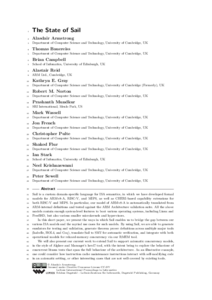The State of Sail
[pdf]
SpISA 2019 Workshop on Instruction Set Architecture Specification
Portland, Oregon, USA
September 2019
Abstract
Sail is a custom domain-specific language for ISA semantics, in which we have developed formal models for ARMv8-A, RISC-V, and MIPS, as well as CHERI-based capability extensions for both RISC-V and MIPS. In particular, our model of ARMv8-A is automatically translated from ARM-internal definitions and tested against the ARM Architecture validation suite. All the above models contain enough system-level features to boot various operating systems, including Linux and FreeBSD, but also various smaller microkernels and hypervisors.
In this short paper, we present the ways in which Sail enables us to bridge the gap between our various ISA models and the myriad use cases for such models. By using Sail, we are able to generate emulators for testing and validation, generate theorem prover definitions across multiple major tools (Isabelle, HOL4, and Coq), translate Sail to SMT for automatic verification, and integrate with both operational models for relaxed-memory concurrency via our RMEM tool.
We will also present our current work to extend Sail to support axiomatic concurrency models, in the style of Alglave and Maranget’s herd7 tool, with the intent being to explore the behaviour of concurrent litmus tests that span the full behaviour of the architecture. As an illustrative example, one could consider how instruction cache maintenance instructions interact with self-modifying code in an axiomatic setting, or other interesting cases that are not well-covered by existing tools

BibTeX
@article{conf/spisa19/armstrong , abstract = {Sail is a custom domain-specific language for ISA semantics, in which we have developed formal models for ARMv8-A, RISC-V, and MIPS, as well as CHERI-based capability extensions for both RISC-V and MIPS. In particular, our model of ARMv8-A is automatically translated from ARM-internal definitions and tested against the ARM Architecture validation suite. All the above models contain enough system-level features to boot various operating systems, including Linux and FreeBSD, but also various smaller microkernels and hypervisors.
In this short paper, we present the ways in which Sail enables us to bridge the gap between our various ISA models and the myriad use cases for such models. By using Sail, we are able to generate emulators for testing and validation, generate theorem prover definitions across multiple major tools (Isabelle, HOL4, and Coq), translate Sail to SMT for automatic verification, and integrate with both operational models for relaxed-memory concurrency via our RMEM tool.
We will also present our current work to extend Sail to support axiomatic concurrency models, in the style of Alglave and Maranget’s herd7 tool, with the intent being to explore the behaviour of concurrent litmus tests that span the full behaviour of the architecture. As an illustrative example, one could consider how instruction cache maintenance instructions interact with self-modifying code in an axiomatic setting, or other interesting cases that are not well-covered by existing tools } , ar_file = {SpISA_19} , ar_shortname = {SpISA 19} , author = {Alasdair Armstrong and Thomas Bauereiss and Brian Campbell and Alastair Reid and Kathryn E. Gray and Robert Norton and Prashanth Mundkur and Mark Wassell and Jon French and Christopher Pulte and Shaked Flur and Ian Stark and Neel Krishnaswami and Peter Sewell} , booktitle = {SpISA 2019: Workshop on Instruction Set Architecture Specification} , file = {spisa2019.pdf} , location = {Portland, Oregon, USA} , month = {September} , png = {spisa2019.png} , title = {{T}he {S}tate of {S}ail} , year = {2019} }